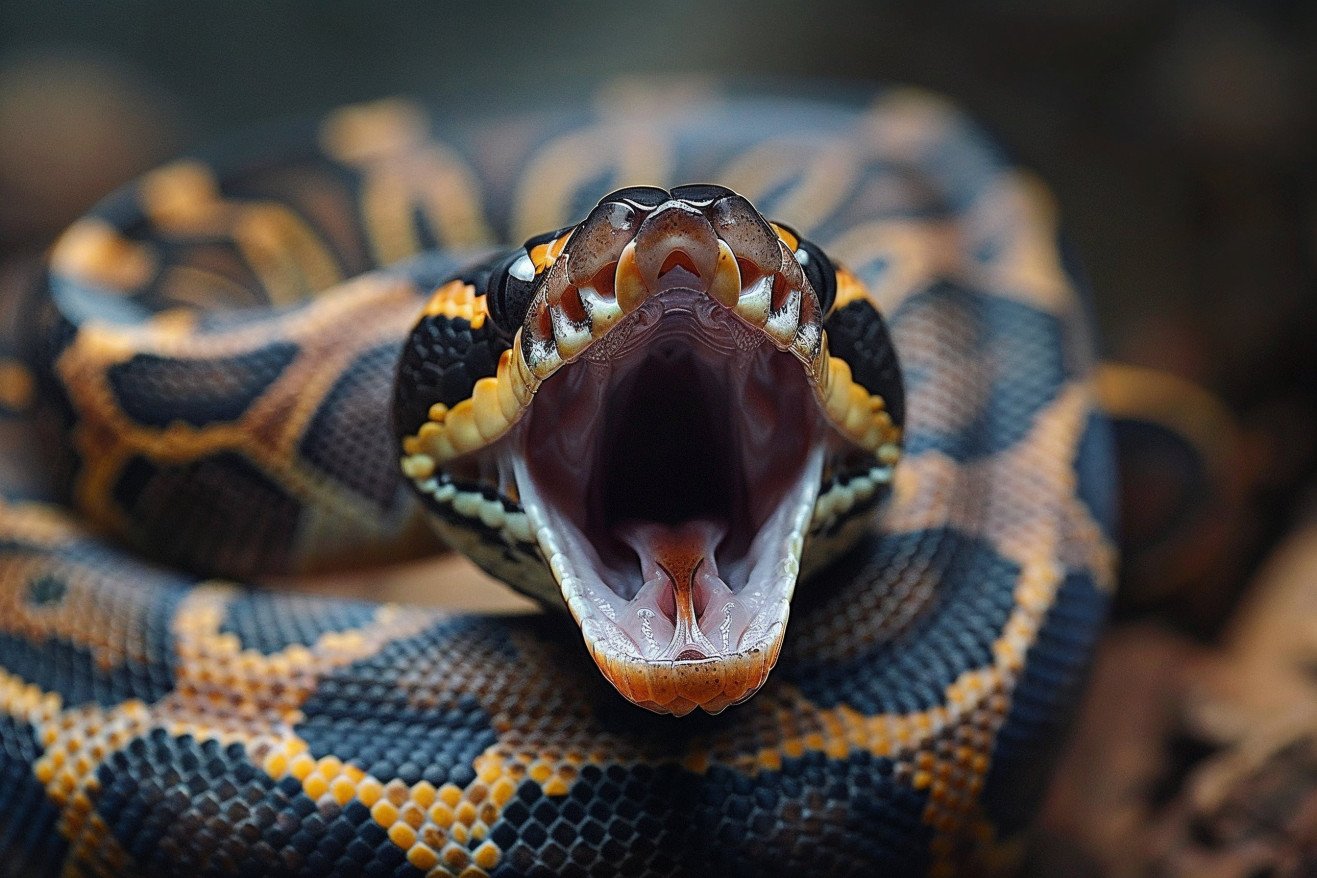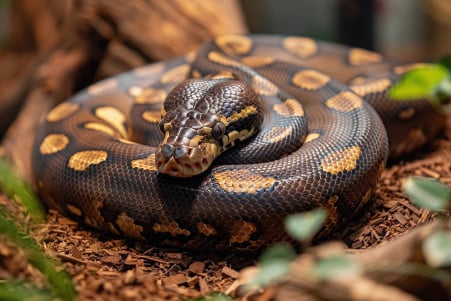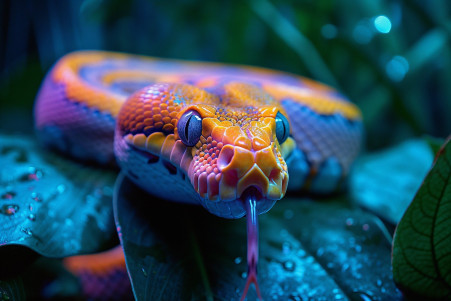Why Do Snakes Yawn? The Science of Mouth Gaping
4 March 2024 • Updated 4 March 2024

When you see a snake yawn, it may look a lot like a human yawn, but what’s really happening inside the snake’s mouth? While it may look like a yawn, snakes are actually mouth gaping, a behavior that snakes naturally do to reset their jaws, especially after eating large prey.
Mouth gaping is not a sign of sleepiness, but it is important for their feeding physiology and may even play a role in their ability to sense the world around them.
In this deeper look at snake behavior, we draw on interdisciplinary research from herpetology, animal physiology, and ethology. This research breaks down the anatomical and behavioral mechanisms of what looks like yawning, helping to give a complete picture of this behavior. By looking at these studies, we can understand the biological role of ‘yawn-like’ behaviors in snakes and how they impact and are impacted by the environment.
Why do snakes yawn?
The Physical Phenomenon of Snake ‘Yawning’
The ability to ‘yawn’ in snakes is an amazing physical phenomenon that has nothing to do with sleep and everything to do with the way snakes are built. As the blog Life is short, but snakes are long explains, the snake skull is full of highly mobile parts, including the quadrate bone, which allows the left and right sides of the jaw to move independently.
This complex structure, which is full of joints and other connections, is what allows snakes to open their mouths so wide to swallow large prey.
In addition, the ligaments that connect the bones of the snake skull are very elastic, as a study from Integrative Organismal Biology, cited in Scientific American, points out. This makes the snake jaw even more flexible, and it’s the ligaments and the bones of the jaw that are important in the ‘yawning’ process, which is essentially mouth gaping for snakes.
In this process, the lower jaw disarticulates and moves forward, a movement that’s made possible by the loose connection at the front of the jaw and the mobile quadrate bone.
Differences in the jaw structure of different species of snakes, such as the blindsnakes that were the focus of a study by scientists at the University of Alberta that was published in the American Association for Anatomy’s journal, Anatomical Sciences, show that different evolutionary paths have led to different feeding behaviors.
These differences are proof that the physical phenomenon of snake ‘yawning’ is closely tied to the physiological and biological factors that have shaped snakes’ survival and hunting techniques.
Sensory Function of ‘Yawning’ in Snakes
The snake yawn is a sensory ritual that is both important and often overlooked. Mouth gaping is closely linked to the snake’s sense of smell.
The Jacobson’s organ, a chemosensory structure that plays a key role in scent detection, is located in the roof of the snake’s mouth, according to AnimalSmart.org. By opening their mouths wide, snakes can use their tongues to collect scent molecules from the air and ground and then deposit them directly onto the Jacobson’s organ.
As noted in a Live Science piece on the work of Kurt Schwenk, a professor of ecology and evolutionary biology, the forked nature of the snake’s tongue creates a ‘stereo’ smell effect that allows them to determine the direction of the scent, a skill that is essential for hunting and avoiding predators.
The Jacobson’s organ interprets the information it receives, allowing the snake to build a rich mental map of its surroundings, according to Paige Hudson of elementalscience.com, which is important for the snake’s survival.
The coordinated action of mouth gaping, the tongue, and the sensory organs is evidence of the complexity of snake behavior that goes beyond what the human eye can perceive.
Snakes’ Feeding Behavior
Mouth gaping, or “yawning,” is an important part of snakes’ feeding behavior. To understand why, it’s important to first understand how snakes are able to eat prey that is much larger than their heads.
As detailed in “Swallowing in snakes,” this is a multi-step process that begins at the very tip of the snake’s mouth and ends with an almost inside-out process to move the prey into the stomach.
This includes the pterygoid walk, a step-by-step process detailed by Live Science in which snakes use a back-and-forth motion to move the toothy parts of their upper jaw over the prey, essentially walking their mouth over and around the prey.
In addition, snakes use a series of body waves to help push the prey down as they swallow. These waves are similar to the locomotive waves snakes use to move across the ground, but they’re directed inward to help push the prey down. This is a slower, more controlled process than the fast, side-to-side waves snakes use to move.
After a snake has eaten, the frequency of ‘yawning’ may increase as the snake’s body needs to realign after such a big meal. While this behavior is a fascinating example of biological necessity, it can also be a sign for veterinarians to watch for, as frequent or excessive yawning after eating may be a sign of an underlying health problem.
Understanding Atypical ‘Yawning’ in Snakes as a Sign of Poor Health
While the occasional ‘yawn’ in snakes is a normal part of post-feeding behavior, if a snake is yawning frequently or at other times, it could be a sign of an underlying health issue.
Creatures of Nightshade notes that a snake that is unwell will often yawn in a way that is less dramatic and less frequent than the wide-mouthed yawns that happen after feeding. This can be especially concerning if the snake is also showing other signs such as a partial mouth opening that happens multiple times in a day, as this could be a sign of a respiratory infection.
A typical ‘yawn’ for a snake will happen a few times in a row, and will only happen after a meal. However, Arizona Exotics explains that there are some health issues that may cause a snake to yawn more often, including a snake that is breathing with its mouth open all the time, or a snake that has a watery discharge.
This is why it’s important to pay attention to a snake’s yawns, as they can be an important part of assessing a snake’s health. When combined with other symptoms, they can help you understand what’s going on with your snake and help you know when to seek veterinary care.
This is why it’s so important for snake owners to understand what their snake’s yawns mean, as it can help them ensure their pet stays healthy.
The Science Behind Snake Yawning
In the world of snakes, yawning is not a sign of being tired, but a complex and important physiological process. More accurately called mouth gaping, this behavior is a gateway to the unique anatomy and sensory biology of these amazing animals.
Snakes’ highly mobile jaw structures make it possible, and it allows them to extend far beyond the limits of their long, thin bodies to swallow large prey. Mouth gaping is not only used to reset their jaws after eating, but also to improve their sense of smell, which is important for hunting or avoiding predators via the Jacobson’s organ.
By learning about this behavior, we can learn about the role mouth gaping plays in snakes’ lives—from the specific movements of the ‘pterygoid walk’ during swallowing to the potential health implications of excessive or unusual mouth gaping. Understanding the details of these behaviors is important for the proper care and keeping of snakes, and will help ensure that they are well taken care of.
The physiology of snakes demonstrates the phenomenon of yawning as an example of the adaptability of evolution. This adaptability is an example of the fine line between form and function, survival, and health in the animal world. Our investigation is another example of the amazing adaptability and strength that nature builds into its creatures.


